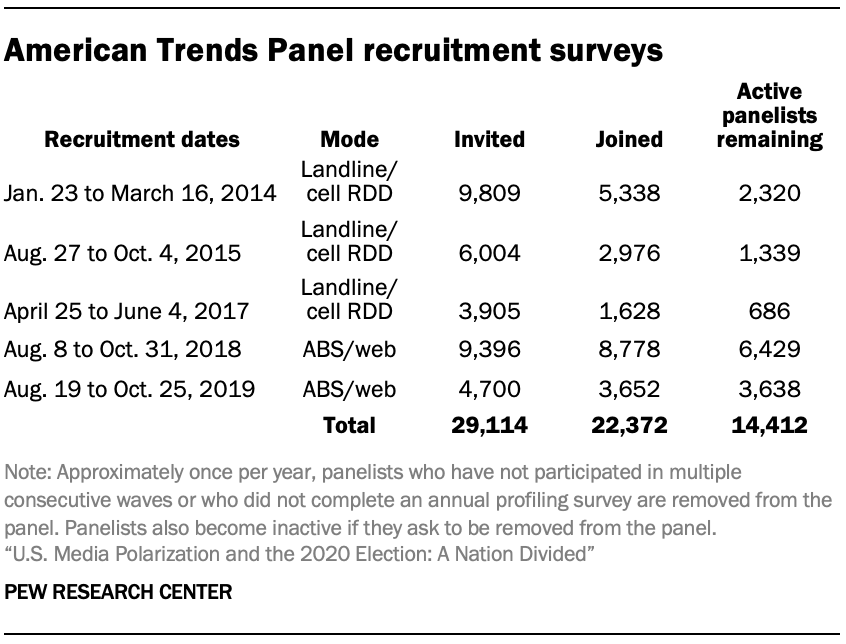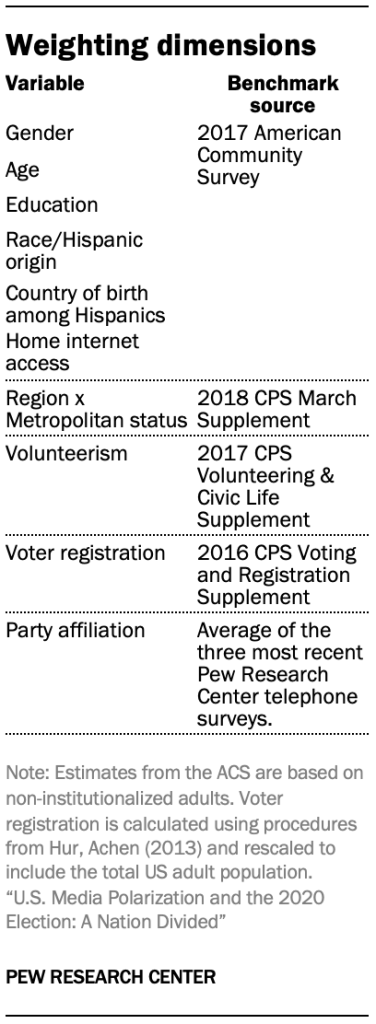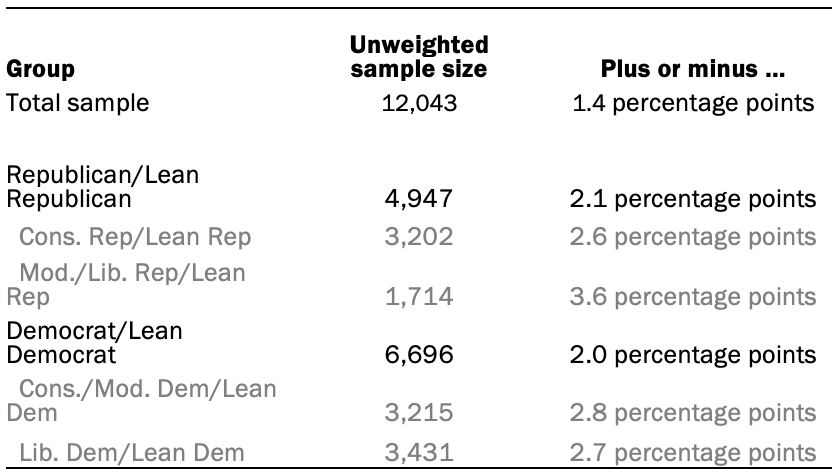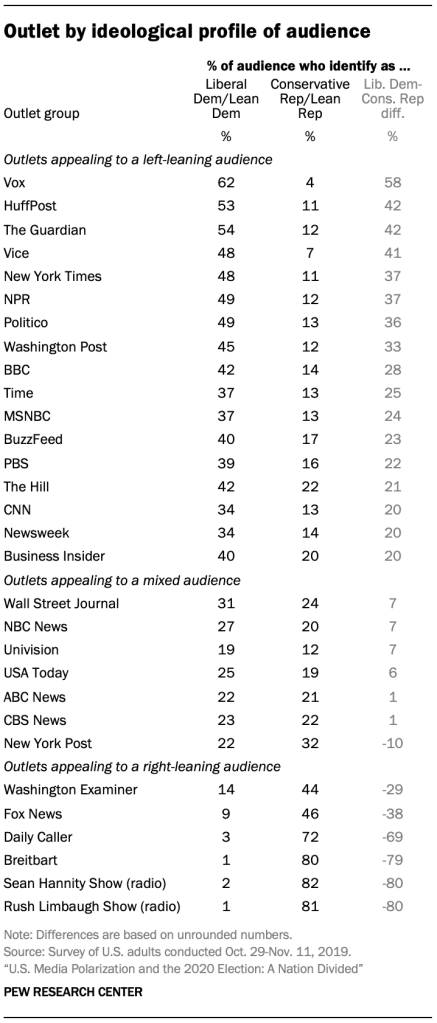American Trends Panel survey methodology
The American Trends Panel (ATP), created by Pew Research Center, is a nationally representative panel of randomly selected U.S. adults. Panelists participate via self-administered web surveys. Panelists who do not have internet access at home are provided a tablet and wireless internet connection. The panel is being managed by Ipsos.

Data in the Election News Pathways project and the U.S. Media Polarization and the 2020 Election report are drawn from the panel wave conducted Oct. 29-Nov. 11, 2019. A total of 12,043 panelists responded out of 14,412 who were sampled, for a response rate of 84%. This does not include 12 panelists who were removed from the data due to extremely high rates of refusal or straightlining. The cumulative response rate accounting for nonresponse to the recruitment surveys and attrition is 4.5%. The break-off rate among panelists who logged onto the survey and completed at least one item is 0.2%. The margin of sampling error for the full sample of 12,043 respondents is plus or minus 1.43 percentage points.
The ATP was created in 2014, with the first cohort of panelists invited to join the panel at the end of a large national, landline and cellphone random-digit-dial survey that was conducted in both English and Spanish. Two additional recruitments were conducted using the same method in 2015 and 2017, respectively. Across these three surveys, a total of 19,718 adults were invited to join the ATP, of which 9,942 agreed to participate.
In August 2018, the ATP switched from telephone to address-based recruitment. Invitations were sent to a random, address-based sample (ABS) of households selected from the U.S. Postal Service’s Delivery Sequence File. In each household, the adult with the next birthday was asked to go online to complete a survey, at the end of which they were invited to join the panel. For a random half-sample of invitations, households without internet access were instructed to return a postcard. These households were contacted by telephone and sent a tablet if they agreed to participate. A total of 9,396 were invited to join the panel, and 8,778 agreed to join the panel and completed an initial profile survey. The same recruitment procedure was carried out on Aug. 19, 2019, from which a total of 4,700 were invited to join the panel and 3,652 agreed as of Oct. 25, 2019. Of the 22,372 individuals who have ever joined the ATP, 14,412 remained active panelists and continued to receive survey invitations at the time this survey was conducted.

The U.S. Postal Service’s Delivery Sequence File has been estimated to cover as much as 98% of the population, although some studies suggest that the coverage could be in the low 90% range3
Weighting
The ATP data were weighted in a multistep process that begins with a base weight incorporating the respondents’ original selection probability. The next step in the weighting uses an iterative technique that aligns the sample to population benchmarks on the dimensions listed in the accompanying table.
Sampling errors and test of statistical significance take into account the effect of weighting. Interviews are conducted in both English and Spanish.
In addition to sampling error, one should bear in mind that question wording and practical difficulties in conducting surveys can introduce error or bias into the findings of opinion polls.
The following table shows the unweighted sample sizes and the error attributable to sampling that would be expected at the 95% level of confidence for different groups in the survey:

Sample sizes and sampling errors for other subgroups are available upon request.
© Pew Research Center, 2020
Selection of news sources
The 30 sources included in the Election News Pathways project were chosen so that respondents were asked about a range of news media across different platforms (e.g., television, print, radio, internet). Researchers also considered audience size, topic areas covered and relevance to political news during the 2016 election and afterwards.
The final list of 30 news outlets asked about consists of the following: four of the major broadcast television networks (ABC News, CBS News, NBC News and Univision), three major cable television news networks (CNN, Fox News and MSNBC), four of the largest newspapers by national circulation (The New York Times, The Washington Post, The Wall Street Journal and USA Today), the two major public broadcast networks (NPR and PBS), two political news radio programs with large audiences (The Rush Limbaugh Show and The Sean Hannity Show), two international media organizations with large domestic audiences (BBC and The Guardian), news websites regardless of their original platform that cover politics and had comparatively high traffic during the fourth quarter of 2018 (BuzzFeed, Vice, New York Post, Time magazine, Newsweek, Politico and Vox), one business-focused outlet with political content and higher web traffic in the time period analyzed than other similar outlets (Business Insider), and other outlets included in external lists of key political sources during the 2016 presidential election and after, selected with traffic and social media engagement figures in mind (Breitbart, The Hill, Daily Caller, HuffPost and The Washington Examiner).4 News sources that mostly serve as aggregators of news (e.g., Google News) and social media outlets were asked about in a separate question.
Main source of political and election news
In addition to the series of questions about these specific outlets, respondents were also asked in an open-ended question to volunteer their main source for news. This allowed respondents to name any source, not limiting them to the specific ones asked about in the survey questions. If respondents volunteered more than one source, the first one mentioned was accepted.
Researchers grouped these open-ended responses together by brand; for instance “NY Times,” “NYT” and “nytimes.com” would all be counted as indicating that The New York Times was the respondent’s main source. Additionally, individual local news sources were grouped together into categories such as “local newspapers” and “local TV.”
All outlets that were named by 1.0% or more respondents as their main source for news are reported in the topline. All other sources named are grouped into “Other”.
Awareness, trust, distrust and use of news sources
In this study, respondents were asked about their awareness of and trust in 30 different news sources. Respondents were first asked whether they have heard of each source. Icons for and names of the sources were arrayed on two screens of 15 sources each.5 The order of the sources on each screen and the order of the two screens were randomized. Respondents were then shown a grid of just the sources that they had heard of and asked to click on the ones they trust for political and election news. They then saw a grid that showed the sources they had heard of but had not indicated that they trust and were asked if they distrust the remaining sources. If a respondent had heard of a source but did not indicate trust or distrust of it, the response was considered “neither trust nor distrust.” Finally, respondents were asked if they got political or election news in the past week from any of the sources that they heard of.
Average audience placement of each outlet based on party and ideology
One section of the report shows the average audience placement of each of the 30 news outlets in a number line based on an index of self-reported party identification and political ideology. Each respondent was assigned a value on a nine-point index based on their responses to questions about their party identification and political ideology. The placement of each outlet’s audience is based on the average value of those who reported getting political and election news from the outlet in the past week. The number values in the index are:
- 1 = Very conservative Republican/Lean Republican
- 2 = Conservative Republican/Lean Republican
- 3 = Moderate Republican/Lean Republican
- 4 = Liberal or very liberal Republican/Lean Republican
- 5 = No lean/Other response
- 6 = Conservative or very conservative Democrat/Lean Democrat
- 7 = Moderate Democrat/Lean Democrat
- 8 = Liberal Democrat/Lean Democrat
- 9 = Very liberal Democrat/Lean Democrat
Outlet groupings by audience makeup

Each outlet was grouped according to the ideological composition of its audience. This grouping is based on the ratio of the proportion of the audience who self-identify as liberal Democrats (including independents who lean Democratic) to the proportion that identify as conservative Republicans (including independents who lean Republican).
The survey asked respondents to indicate whether they got “political and election news” from 30 national news outlets in the past week. An outlet is considered to have a left-leaning audience if the proportion of those who got news there that identify as liberal Democrats is at least two-thirds higher than the proportion that identify as conservative Republicans. Alternatively, an outlet is considered to have a right-leaning audience if the proportion of all audience members that identify as conservative Republicans is at least two-thirds higher than the proportion that identify as liberal Democrats. And an outlet is classified as having a mixed audience if neither liberal Democrats nor conservative Republicans make up at least two-thirds or more of the audience than the other.
Data for classifying the ideological composition of news outlets comes from the first survey of Pew Research Center’s Election News Pathways project, conducted Oct. 29-Nov. 11, 2019, among 12,043 U.S. adults.